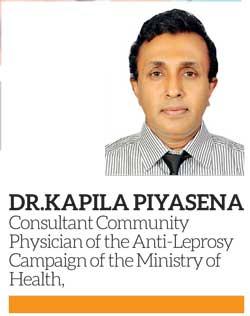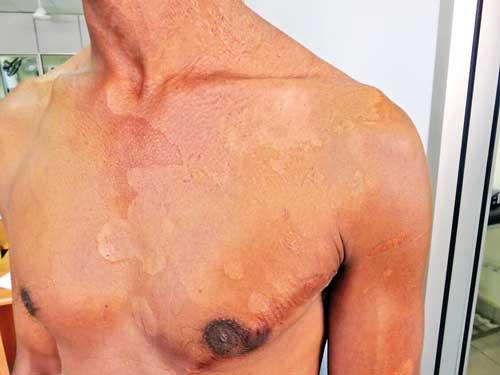29 Jan 2021 - {{hitsCtrl.values.hits}}
 The World Leprosy Day is observed on the last Sunday in January every year and is a disease that many people believe to be extinct. However, according to the World Health Organization (WHO) nearly 600 more people are diagnosed every day with this condition and start treatment for leprosy; it is estimated that millions more go undiagnosed.
The World Leprosy Day is observed on the last Sunday in January every year and is a disease that many people believe to be extinct. However, according to the World Health Organization (WHO) nearly 600 more people are diagnosed every day with this condition and start treatment for leprosy; it is estimated that millions more go undiagnosed.
explains that the history of leprosy goes back to more than 2000 years ago. In 1708, the first leprosy hospital was built in Sri Lanka and at that time once a person was diagnosed with leprosy no treatment was available. Therefore once diagnosed such patients were quarantined for life. He said that in the 1940s the dapsone drug treatment was introduced for leprosy and patients were cured after treatment.

“But later they found out that there were some resistant cases when dapsone alone was administered as it resulted in development of drug resistance to that drug.” As a solution, in 1970s (In 1983 in Sri Lanka), Multidrug therapy (MDT) was introduced and it produced a 100% success rate.
With this treatment, leprosy patients were completely cured and by 1995 the number of Leprosy patients had been drastically reduced and Sri Lanka reached the leprosy elimination stage.
“The biggest misconception among people is that leprosy is no more in Sri Lanka. Because of this, awareness and enthusiasm among people as well as in the Health Ministry has lessened. This is the current problem in Sri Lanka,” Dr. Piyasena emphasised.

In Sri Lanka, we have nearly 2, 000 newly diagnosed leprosy cases per year. In 2019, only 1660 were diagnosed with it and Dr. Piyasena believes that this lesser number is due to the lack of awareness among people. “If they were aware of the disease and got diagnosed quickly, the numbers would increase,” he commented.
It is of concern that about 10% of the diagnosed cases i.e. about 181 cases were children and that 93 of the total number of patients were having deformities. “Because of the lack of awareness, people tend not to seek medical attention promptly as soon as initial symptoms appear, resulting them to be diagnosed in latter stages,” he added.
Understanding Leprosy
Leprosy (Hansen’s disease) is an infectious disease caused by the bacterium Mycobacterium leprae. However, leprosy is not as infectious as COVID-19. One would need to a continuous long-term exposure to the bacteria to be infected. “Therefore, if a leprosy patient who is seated next to you in a bus sneezes and you inhale it, this does not mean you would get infected,” Dr. Piyasena commented adding, “Your immunity will play a major part and apart from that, you need a continuous exposure to get the leprosy. And once you get the disease there is a long incubation period. Once you are infected it takes about minimum two years for symptoms to appear. Sometimes even 20 years.”
If there is a history of leprosy in your family or close contacts, there is a chance you might be infected. Continuous long-term contact with the infected would increase the risk of contracting the disease. “Therefore, please be examined by your dermatologist at least biannually to ensure early diagnosis and treatment,” Dr. Piyasena advised.
Symptoms and possible complications
Because the bacteria particularly love to live in a lower temperature than the body temperature, its most preferred habitat in our bodies is the skin. The earliest symptoms of leprosy are skin lesions that are lighter than your normal skin colour. The disease can progress and the bacteria can erode in to your hair follicles and therefore we can observe a loss of hair in the affected area.
“The bacteria attacks peripheral nerves and autonomic nerves in that area resulting in reduced sensation to touch, heat, or pain in the affected area and no sweating can be observed in that area as well,” Dr. Piyasena said. These symptoms are followed by the numbness and tingling sensation of the hands and legs. Eventually, if not treated, nerves gradually deteriorate and you won’t feel any sensation at all. Owing to the lack of sensation, patients tend to get burnt and injured easily resulting in wounds and sores. You may fail to notice these wounds as the sensation is lost. Due to the lack of flesh in the wounds, infection may spread to the bones which is known as osteomyelitis. In most cases of osteomyelitis, a patient could lose digit by digit of their fingers and toes.
Similarly, the bacteria can also damage the eyes. The facial nerve that controls closing and opening of the eye may be affected resulting in the inability to close the eyes. When a patient cannot close the eyelids, the eyes get dried up, eventually leading to blindness. The infection affects the cartilage of the patient’s nose and ears and they start eroding, thus causing more facial disfigurement. This is a clear picture of a leprosy patient before 1950s when no treatment was available.
“Because of this fearsome image of leprosy, there is a stigma surrounding the disease. People are scared to seek medical attention for leprosy because they think it’s not curable. But leprosy is completely curable. And you don’t need to be quarantined. As soon as you take the medicine you are not infectious to others. So you can stay at home and get the treatment. And you won’t be subjected to any deformities once you obtain treatment as early as possible,” Dr. Piyasena explained.
Diagnosis and Treatment
Now though once people identify the symptoms in the early stages and get diagnosed and treated, they would be safe from further complications of the disease. Once suspected a biopsy of the skin lesion can be done. In the event it is a case of a suspected leprosy patient, an ear lobe biopsy / smear can be done to determine the condition.
Once diagnosed, the MDT treatment allows patients to be cured completely. The treatment includes a combination of drugs rifampicin, clofazimine and dapsone. However, if the disease is not diagnosed early, complications leading to deformities may be resulted. Therefore Dr. Piyasena advised patients to get treated as early as possible to avoid further complications of the disease.
21 Dec 2024 34 minute ago
21 Dec 2024 2 hours ago
21 Dec 2024 5 hours ago
21 Dec 2024 5 hours ago
21 Dec 2024 6 hours ago